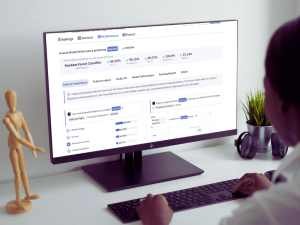How to Generate More Leads with Predictive Analytics and Marketing Automation
Are you struggling to generate more leads, or new leads, for your business? Are you spending countless hours trying to find qualified leads and getting poor results? You’re not alone. Identifying high-potential leads is time-consuming, and you may find yourself drowning in data.
Predictive analytics and marketing automation offer a powerful solution. By combining predictive analytics and marketing automation, you can streamline your lead generation efforts. This helps you to identify the most promising prospects and high quality leads. For each sales lead, you’ll be equipped to craft personalized messaging and tailor your marketing strategies. You might be hesitant to try this route towards finding new sales leads. The challenges you see, however, can be solved with predictive analytics and marketing automation.
We take you through how predictive analytics and marketing automation can help you augment your lead generation efforts. As you look towards attracting new customers, and growing your sales funnel, predictive analytics and marketing automation can play a big role in optimizing your lead generation strategies. The no-code approach makes these tools accessible to everyone, regardless of technical expertise.
What are predictive analytics?
Predictive analytics uses historical data, statistics, and machine learning to predict future outcomes. Predictive modeling is useful for many different business functions. These include: marketing, sales, operations, and finance. Predictive analytics can help you discover opportunities for attracting new business.
What is marketing automation?
Marketing automation automates repetitive marketing tasks. These tasks include, but are not limited to, sending emails, scheduling social media posts, and nurturing leads. By automating these tasks, you free up valuable time and resources to focus on your core business. This is a great way to optimize your marketing strategies to attract new business. Marketing automation can also personalize your customer messaging, making it more relevant and engaging for your target audience.Lead Segmentation and Classification with Predictive Analytics
Combining predictive analytics and marketing automation
Combining predictive analytics and marketing automation enables you to optimize your lead generation strategies and focus on business growth. Your marketing plan and lead generation strategy can benefit from this powerful combination. This combination also helps you guide content marketing plans, optimize your customer support for current customers, and enable business growth.
Focus on the high-value leads
Predictive analytics enables you to identify leads with the highest conversion potential. Predictive analytics also highlights leads and potential clients that are likely to become long-term, valuable customers. Marketing automation then automates tasks and communication with your high-priority leads. By focusing efforts and personalizing communication for these leads, you can significantly boost your lead generation efficiency and conversion rate. This is a great way to help your sales reps focus on priority leads, or guide your marketing team on customer segments you need to focus on. Your sales team will benefit from being able to identify the most important potential client group.

How to implement predictive analytics and marketing automation
You need a plan to implement predictive analytics and marketing automation. Here’s a roadmap to guide you:
- Define your goals and data needs: Start by outlining your goals and the data required to achieve them. Understand your data sources and the tools required for analysis. With this solid foundation, you can build your predictive models and automate marketing processes.
- Assess and clean your data: Data accuracy is paramount. Ensure your data is clean, complete, and up-to-date. This guarantees accurate predictions from your models and smooth operation of your marketing automation workflows. Consider data visualization tools to explore trends and patterns relevant to your lead generation efforts.
- Adopt a continuous improvement approach: The key to successful implementation lies in testing and iteration. Start with a small data set. Test your models and marketing automation workflows. Identify areas for improvement in accuracy and efficiency. Continuously refine your models and workflows until you achieve your desired results. Don’t be afraid to experiment and embrace new approaches. Continuous learning and adaptation are vital in the ever-evolving lead generation landscape.
Lead segmentation
A one-size-fits-all approach simply won’t cut it in lead generation. To convert potential customers into loyal brand advocates, personalization is key. Predictive analytics helps you tailor your lead generation approach in highly beneficial ways. Predictive analytics analyzes past customer and lead data. Predictive analytics uncovers patterns and characteristics that identify leads with higher conversion potential or long-term value. This information enables you to segment leads and c
reate targeted marketing campaigns for each group. Your segmentation strategy involves using data to group leads based on demographics, past purchases, website activity, and social media interactions. Using this information, you can optimize your search engine optimization strategies. You can better focus on your performance in search engines. You’ll be equipped to create an effective landing page for a particular lead segment. You can also optimize your current landing pages to enable higher conversion rates. You can create Facebook Ads and Google Ads that align with particular target audience preferences. You can also assess your website design to see if it truly resonates with the type of customers you’re looking to attract. (Bonus tip: always include some type of social proof on your landing pages, website, or blog posts. Social proof has shown to be highly effective in supporting lead generation and enhancing conversion rates.
If you don’t have any social proof, ask your current customers to share their experiences with your business today).
Lead classification
Predictive analytics goes beyond segmentation with lead classification. By analyzing past data, it assigns scores to leads based on their conversion likelihood or customer value. This empowers you to prioritize your efforts. You’ll have a better idea of how to allocate resources towards leads with higher conversion potential. You can also further tailor your personalized messaging with relevant keywords, based on the assigned score. Perhaps you’re looking to gather email addresses and other contact information. You may be wanting to find out if a particular type of customer wants a free trial from your business. You could be thinking about building a referral program for your business. Regardless of your company size, this type of information helps you target and plan your marketing strategies more effectively.
The challenges and limitations of predictive analytics and marketing automation
While undeniably powerful, predictive analytics and marketing automation do have some challenges and limitations. Here’s what you need to consider:
- You need high-quality data: Predictive analytics models rely heavily on data to make accurate predictions. Incomplete, inconsistent, or biased data leads to inaccurate models and misleading results. This can be especially challenging if you have limited data or data scattered across multiple systems.
- You still need the human touch: While these tools enhance efficiency and effectiveness, they shouldn’t replace human decision-making. Look towards achieving a healthy balance. Leverage the technology’s power and human expertise to and act on the insights provided. Over Reliance on specific models or algorithms can be risky, as they may become outdated or less effective over time.
- Customization is key: No matter your company size or operations, you still need customization. Different businesses have different needs and goals. What works for one company might not work for another. Carefully evaluate your specific requirements and capabilities before investing. Be open to experimentation and adaptation to find the perfect fit.
- You need expertise: Implementing these tools effectively requires resources and expertise. Consider adding data scientists, marketing analysts, and IT support providers to your team.
Despite the challenges, the benefits of predictive analytics and marketing automation are undeniable. These tools streamline lead generation processes, prioritize high-value leads, and enable personalized communication, ultimately leading to more leads and business growth. The good news is this: You don’t need a data science degree to get started. No-code predictive analytics platforms like Graphite Note make these tools accessible to everyone, regardless of technical background. These platforms offer user-friendly interfaces and pre-built templates, enabling you to leverage the power of predictive analytics and marketing automation quickly and easily.






